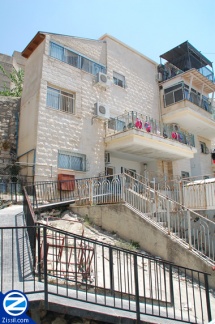Sanz Community Safed
 | |
| Hebrew: | |
|---|---|
| קהילת צאנז צפת | |
| Pronunciation: | |
| Tz-zanz | |
| Other Names: | |
| Sanzer Chassidim in Tzfat | |
| Description: | |
| Sanz Hassidic community in Tzfat. |
The Sanz community in Tzfat has an long history in the city. Sanz Hassidim settled in the city in the 1870s. Few Sanz residents remained after Israel’s War of Independence but the community was revived in the 1970s.
Contents |
[edit] History
The Sanz community has existed in Tzfat for almost 150 years.
[edit] 19th Centry
The founder of the Sanz Hassidic dynasty, Rabbi Chaim Halberstam of Sanz, supported Jewish settlement in the Land of Israel and encouraged those of his followers who were able to make the move. The Rabbi, known as the “Divrei Chaim”, sent his eldest son, Rabbi Yechezkel Shraga Halberstam, to Safed to build the community’s synagogue and strengthen the Sanz followers who lived in the city. Approximately 100 Sanz Hassidim worked and studied in Tzfat in the late 19th century. Rabbi Yechezkel Shraga, known as the “Divrei Yechezkel.” built the original Sanz “shteibel” -- small synagogue -- near the Kikar Hameginim square. A Sanz synagogue was later build on Tarpat street.
[edit] 20th Century
A 20th century descendant of the Divrei Chaim, also named Rabbi Yekutiel Yehuda Halberstam, survived the Nazi death camps and assumed leadership of the Klausenberger-Sanz Hassidic dynasty. He considered immigrating to Tzfat and establishing his Hassidic court in the city but, in the end, moved to Netanya where he build Sanz institutions and the world-renown Laniado hospital. His Netanya community grew and in the 1970s he instructed some of his followers to begin rebuilding the Sanz community in Tzfat.
[edit] Rebuilding
The rebuilding began with the existing Sanz synagogue, located on Tarpat street in the Old Jewish Quarter. The entire building was rebuilt save for the southern wall which had remained from the original synagogue building. This wall holds the synagogue’s “Aron Kodesh” -- Ark of the Torah scrolls. Further developments in the complex included the renovation of the synagogue’s “mikve” -- ritual bath -- and the construction of the Heichal Zichron Yitzchak “Beit Midrash” -- House of Study -- which was paid for by a Holocaust survivor who used his war reparations to fund the project.
![]() Read full Zissil article on the Sanz Shul of Tzfat
Read full Zissil article on the Sanz Shul of Tzfat
[edit] Housing
Across the street from the synagogue the Sanz community build “Kiryat Sanz,” a housing project of approximately 40 apartments which house both families who are associated with the Sanz community as well as other “Haredi” -- ultra-orthodox -- families. The complex spans the hillside from Tarpat Street to Hatam Sofer street and the apartments were built to meet the needs of the religious residents, with “succa porches” where families could build their succas for the Succot holiday and special areas to store Passover utensils.
[edit] Education
Sanz does not operate their own educational institutions in Tzfat but young boys from Sanz families generally attend the Tachover “Cheder” -- elementary school -- near Kikar Meginim in the Old Jewish Quarter or the Yiddish “Cheder” in the Meor Chaim neighborhood in Tzfat’s Southern neighborhood. Both cheders are Yiddish-speaking. Girls from Sanz families attend either of the Beis Ya’akov girls’ schools in Tzfat which are located in Meor Chaim neighborhood or near the great stairs in the Old Jewish Quarter. Some Sanz girls attend the Yiddish-speaking Satmar girls’ school in Meor Chaim. Boys leave Tzfat after their Bar Mitzva to attend a yeshiva in Netanya.
| |||||||||||

